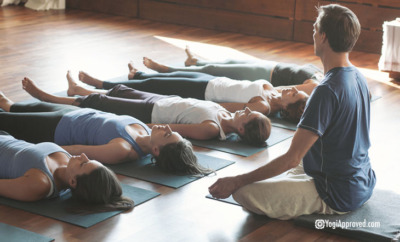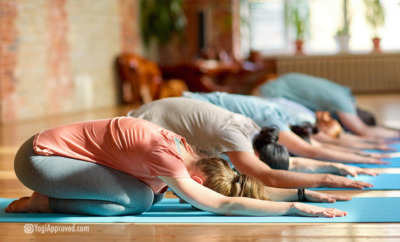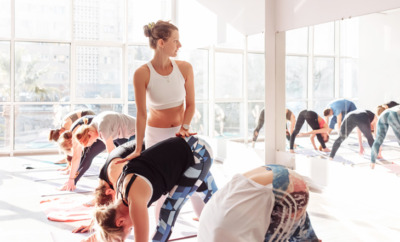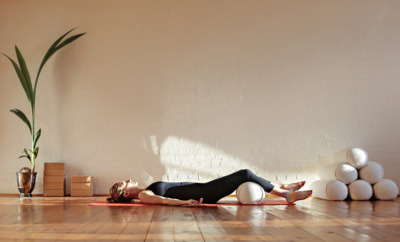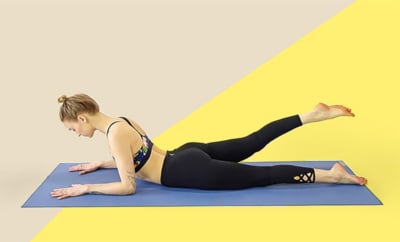Everything You Need to Know About Teaching Yoga at a Gym

TeachYoga gym featured image
It’s no secret in the yoga instructor world that teaching yoga at a gym is far different than teaching it at a yoga studio. Part of becoming a yoga instructor and changing the world in your own special way is deciding whether you belong at a big global gym, your local yoga studio, a CrossFit gym, or perhaps a mix of all three.
Chances are, most of your training took place at a yoga studio. All that time spent during your yoga teacher training (or YTT) in a studio helped make you feel more comfortable about teaching in one. Yet what about teaching yoga at an athletic club or gym? Many teachers would love to teach yoga outside of the yoga studio, but don’t have experience in how to go about it, or even perspective on how it’s different.
So, from a yogi who actually prefers teaching at a gym rather than a yoga studio, here’s what you need to know before you teach yoga at a gym:
It will be louder than you’re used to
Whether you’re in a small crossfit box or a huge multi-level gym, chances are there will be more going on than just your yoga class. It might be the clangs and grunts of weight lifting or some variation of loud and obnoxious music. Just know that the rest of the gym isn’t going to be very yogic. Basically, just be ready for the opposite of incense and soft chanting music.
The student vibe is different
Expect people to leave early or arrive late. People will come before or after another part of their workout routine, or stop in to try it for the first time since it’s probably offered as part of their membership.
Expect lots of newbies and students of all levels and backgrounds. It can be challenging, but it’s also a great opportunity to share yoga with people who wouldn’t otherwise try it.
Tailor your teaching for the gym
Don’t be afraid to alter your teaching style from the yoga studio to the gym. Everything from the lighting to the music, to the poses you focus on will be slightly different. One of the best things I ever did during my classes was strike up conversation with my students.
Nowadays, we often talk and listen to 2Pac while we’re sitting in stretches like Pigeon pose or Runner’s Lunge. Not only has this gotten my students more excited about yoga, but it’s caused my class sizes at the gym to grow.
Communication is key
Ask your students if they have anything specific that they want to work on. Chances are you’ll get comments about tight hamstrings, a sore lower back, etc. – all things that are pretty much the yoga teacher’s bread and butter. This will help you build relationships with your students as you get the opportunity to use yoga to improve their mobility and overall athletic performance.
Athletes have different goals
Always remember the intentions and goals of your students, wherever you are. And know that at a gym, your yoga student’s goals will often times be less spiritual and probably a lot more physically-oriented. Gym yogis want to increase their flexibility, balance, and mobility. They probably aren’t as accustomed to chanting or practicing pranayama.
Be prepared for feedback
You will have athletes in your class that haven’t tried yoga or done a lot of it in the past. Be prepared for people to tell you that they didn’t like yoga (after only trying it once), but never take it personally. Be prepared for the people who ask a lot of questions or need a lot of help with their alignment.
You are dealing with a broader range of backgrounds and experience levels in a gym setting. Being able to cater to all of them is a must.
Get creative!
If the surroundings are too distracting in the gym or if people are loudly socializing at the start of class, what do you do? These are the moments that make a yoga instructor. For the days my class seems particularly free spirited, I always have a few partner yoga poses prepared to break up the stagnant stretching. Be okay with things not being perfectly structured!
I’ve also found it useful to create new kinds of classes that draw in more students. For example, at my CrossFit gym we offer classes that include 30 minutes of metabolic conditioning and 30 minutes of yoga. Never be afraid to try something new!
Savasana is a unique challenge for gym yogis
I can’t even count the amount of times that an athlete has gotten up and left my class during savasana, or sat up on their mat and stared at me like I was crazy. Most gym goers are not accustomed to resting peacefully for 5 minutes after a workout. Add the outside noises and amped up energy of a gym and suddenly savasana just got a lot more challenging. Nothing you can’t handle – just a good reminder to get creative.
Teaching yoga at a gym, health club, or athletic club is certainly a change of pace from teaching at a yoga studio. Some yoga teachers gravitate towards one or the other; some teachers love teaching at both for different reasons. Whether teaching yoga at a gym is something that interests you or not, know that it’s a great way to bring yoga to a diverse group of people in a fun and challenging atmosphere.
Leave us a comment and let us know how you feel about teaching yoga at a gym vs. a yoga studio. Or ask any questions you may have regarding transitioning your teaching from the studio to the gym. We love hearing from you!


This Month's Letter
From the Editor
Monthly motivation and food for
thought from our founder.



